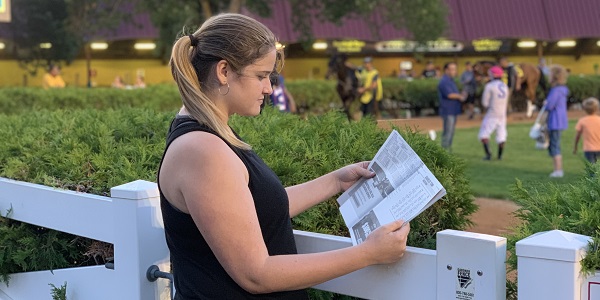By Lexi Mueller
Horse racing is a fun pastime for many at Canterbury Park, where they can come, bet on horses, and hopefully win enough money to pay for the beer they drank. But for others, horse racing has become more than just a pastime. The art of handicapping has advanced horse racing, as racing enthusiasts can use information on the horse, track, and much more to help identify a winning horse. Handicapping requires bettors do their research before each race and use all their resources, such as the Daily Racing Form, to pick the best horse to bet on.
As a relative newcomer to racing, I had very little knowledge on the complexities that can go behind choosing a winning horse. As a child, and often still in my early 20’s, I have always made all of my betting decisions on either the colors or names of the horses. Before being introduced to handicapping, I had little to no knowledge of all of the factors that play into building a fast and athletic racehorse.
At the Chalk Pub on a Wednesday night early this summer, Jeff Maday and Brian Arrigoni, two handicapping specialists at Canterbury, gave me and a large group of guests a deeper look into the art of handicapping. The event, Handicapping and Hops, was hosted by Canterbury to help racing enthusiasts make more informed decisions when betting on races.
Trainees to handicapping, like myself, were thrown right in the thick of things as Maday and Arrigoni took us through a deep dive of the Daily Racing Form, which they believe to be an absolute essential for a person pursuing the art of handicapping. The Form is essentially a large packet of statistics on every horse racing that night, offering people the chance to do their research before making a bet.
As a newcomer, it took me a while to fully begin understanding what the statistics on the form meant and how to read it correctly. But, eventually, I began to understand what a beginner like me should be looking for when attempting to choose a winning horse. I started to figure out the different track styles, the strengths and disadvantages of horses on turf or dirt tracks, why a trainer matters as much as they do, and how much the jockey really influences the race. Jareth Loveberry, a popular jockey at Canterbury, also joined the panel and gave his own take on handicapping through the eyes of someone on the track.
While there is still so much more to learn about the art of handicapping, trainees like me were able to walk out of the program with better knowledge of where to find information and how to read it. Veteran handicappers also benefited from the insider tips of specialists who work at the track.
While I’m still not fully positive of my ability to bet and handicap with the pros, listening to these specialists talk about the art to their trade did intrigue me enough to lead me to pull up the Daily Racing Form at home the next day. I took a look at the races happening at Canterbury and suddenly felt much more confident in my ability to bet on a horse I believed had a high chance of winning.
Learning the basics of handicapping did prove to be very worth my time, as my experience watching the races has improved dramatically. I find myself invested in the horses and the art, not just the race itself. So for those of you looking to expand your racing knowledge, make more informed bets, and maybe win a little cash – it may be worth the time to attend this Canterbury Summer School on Saturday morning, August 3.
As Arrigoni said, “If you take just one or two tips from this program, you are already doing better than 90% of the people who walk in those front doors.”
